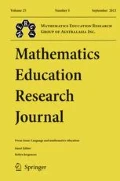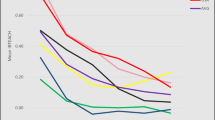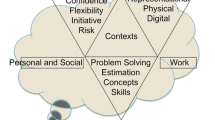Abstract
Despite the recognised importance of mathematical proof in secondary education, there is a limited but growing body of literature indicating how preservice secondary mathematics teachers (PSMTs) view proof and the teaching of proof. The purpose of this survey research was to investigate how PSMTs in Australia, the USA and Korea perceive of proof in the context of secondary mathematics teaching and learning. PSMTs were able to outline various mathematical and pedagogical aspects of proof, including purposes, characteristics, reasons for teaching and imposed constraints. In addition, PSMTs attended to differing, though overlapping, features of proof when asked to determine the extent to which proposed arguments constituted proofs or to decide which arguments they might present to students.
Similar content being viewed by others
References
Adler, J., & Davis, Z. (2006). Opening another black box: Researching mathematics for teaching in mathematics teacher education. Journal for Research in Mathematics Education, 37, 270–296.
Australian Curriculum and Reporting Authority [ACARA]. (2018a). General mathematics. Retrieved from https://www.australiancurriculum.edu.au/senior-secondary-curriculum/mathematics/general-mathematics/?unit=Unit+1&unit=Unit+2&unit=Unit+3&unit=Unit+4. Accessed 20 Dec 2018.
Australian Curriculum and Reporting Authority [ACARA]. (2018b). Mathematical methods. Retrieved from https://www.australiancurriculum.edu.au/senior-secondary-curriculum/mathematics/mathematical-methods/?unit=Unit+1&unit=Unit+2&unit=Unit+3&unit=Unit+4. Accessed 20 Dec 2018.
Australian Curriculum and Reporting Authority [ACARA]. (2018c). Specialist mathematics. Retrieved from https://www.australiancurriculum.edu.au/senior-secondary-curriculum/mathematics/specialist-mathematics/?unit=Unit+1&unit=Unit+2&unit=Unit+3&unit=Unit+4. Accessed 20 Dec 2018.
Baumert, J., Kunter, M., Blum, W., Brunner, M., Voss, T., Jordan, A., et al. (2010). Teachers’ mathematical knowledge, cognitive activation in the classroom, and student progress. American Educational Research Journal, 47(1), 133–180. https://doi.org/10.3102/0002831209345157.
Bergqvist, T. (2005). How students verify conjectures: teachers’ expectations. Journal of Mathematics Teacher Education, 8, 171–191.
Bieda, K. N. (2010). Enacting proof-related tasks in middle school mathematics: challenges and opportunities. Journal for Research in Mathematics Education, 41(4), 351–382.
Bleiler, S. K., Thompson, D. R., & Krajčevski, M. (2014). Providing written feedback on students’ mathematical arguments: proof validations of prospective secondary mathematics teachers. Journal of Mathematics Teacher Education, 17(2), 105–127.
Bleiler-Baxter, S. K., & Pair, J. D. (2017). Engaging students in roles of proof. The Journal of Mathematical Behavior, 47, 16–34.
Boyle, J. D., Bleiler, S. K., Yee, S. P., & Ko, Y. Y. (2015). Transforming perceptions of proof: a four-part instructional sequence. Mathematics Teacher Educator, 4(1), 32–70.
Common Core State Standards Initiative (CCSSI). (2010). Common core state standards. Washington, DC: National Governors Association for Best Practices and Council of Chief State School Officers.
de Villiers, M. (1990). The role and function of proof in mathematics. Pythagoras, 24, 17–24.
Dickerson, D. S., & Doerr, H. M. (2014). High school mathematics teachers’ perspectives on the purposes of mathematical proof in school mathematics. Mathematics Education Research Journal, 26(4), 711–733.
Ellis, A. B., Bieda, K., & Knuth, E. J. (2012). Developing essential understanding of proof and proving for teaching mathematics in grades 9–12. Reston, VA: National Council of Teachers of Mathematics.
Ginsburg, A., Leinwand, S., Noell, J., & Pollock, E. (2009). Reassessing US international mathematics performance: new findings from the 2003 TIMSS and PISA. Colección Digital Eudoxus, 22.
Hanna, G. (1990). Some pedagogical aspects of proof. Interchange, 21(1), 6–13.
Hanna, G. (2000). Proof, explanation and exploration: an overview. Educational Studies in Mathematics, 44, 5–23.
Hanna, G., & de Villiers, M. (2008). ICMI Study 19: proof and proving in mathematics education. ZDM: International Journal on Mathematics Education, 40(2), 329–336.
Harel, G., & Sowder, L. (2007). Toward comprehensive perspectives on the learning and teaching of proof. In F. Lester (Ed.), Second handbook of research on mathematics teaching and learning (pp. 1–60). Reston: National Council of Teachers of Mathematics.
Hill, H. C., Ball, D. L., & Schilling, S. G. (2008). Unpacking pedagogical content knowledge: Conceptualizing and measuring teachers' topic-specific knowledge of students. Journal for research in mathematics education, 39(4) 372–400.
Inglis, M., & Alcock, L. (2012). Expert and novice approaches to reading mathematical proofs. Journal for Research in Mathematics Education, 43, 358–390.
Inglis, M., Mejia-Ramos, J. P., Weber, K., & Alcock, L. (2013). On mathematicians’ different standards when evaluating elementary proofs. Topics in Cognitive Science, 5(2), 270–282.
Jung, S., Lee, J., Park, H., Hong, J., Seo, H., Park, B., & Kang, E. (2011). Junior high school mathematics 2. Seoul, Korea: Geomsung Publishing Company.
Karunakaran, S., Freeburn, B., Konuk, N., & Arbaugh, F. (2014). Improving preservice secondary mathematics teachers’ capability with generic example proofs. Mathematics. The Teacher Educator, 2(2), 158–170.
Knuth, E. J. (2002a). Teachers’ conceptions of proof in the context of secondary school mathematics. Journal of Mathematics Teacher Education, 5(1), 61–88.
Knuth, E. J. (2002b). Secondary school mathematics teachers’ conceptions of proof. Journal for Research in Mathematics Education, 33(5), 379–405.
Ko, Y. Y., & Knuth, E. J. (2013). Validating proofs and counterexamples across content domains: practices of importance for mathematics majors. Journal of Mathematical Behaviour, 32(1), 20–35.
Kotelawala, U. (2009). A survey of teacher beliefs on proving. In F. Lin, F. Hsieh, G. Hanna, & M. de Villiers (Eds.), Proceedings of the ICMI Study 19 Conference: Proof and proving in mathematics education. Vol. 1, pp. 250-255. Taipei, Taiwan. National Taiwan Normal University: Department of Mathematics.
Kotelawala, U. (2016). The status of proving among US secondary mathematics teachers. International Journal of Science and Mathematics Education, 14(6), 1113–1131.
Lesseig, K. (2011). Mathematical knowledge for teaching proof. Unpublished Doctoral Dissertation, Oregon State University.
Lesseig, K. (2016). Investigating mathematical knowledge for teaching proof in professional development. International Journal of Research in Education and Science, 2(2), 253–270.
Mason, J., & Pimm, D. (1984). Generic examples: seeing the general in the particular. Educational Studies in Mathematics, 15(3), 277–289.
Miller, D., Infante, N., & Weber, K. (2017). How mathematicians assign points to student proofs. The Journal of Mathematical Behavior, 49, 24–34.
Ministry of Education, Culture, Sports, Science and Technology of Japan. (2008). Japan middle school course of study: mathematics. Tokyo, Japan: Ministry of Education, Culture, Sports, Science and Technology of Japan.
Ministry of Education of Korea (2015). Korea Mathematics Curriculum. Seoul, Korea: Ministry of Education of Korea.
Ministry of Education of the People’s Republic of China. (2011). China compulsory education mathematics course standard. Shanghai, China: Ministry of Education of the People's Republic of China.
Moore, R. C. (2016). Mathematics professors’ evaluation of students’ proofs: a complex teaching practice. International Journal of Research in Undergraduate Mathematics Education, 2(2), 246–278.
National Council of Teachers of Mathematics [NCTM]. (2009). Focus in high school mathematics: reasoning and sense-making. Reston, VA: National Council of Teachers of Mathematics.
Peressini, D., Borko, H., Romagnano, L., Knuth, E., & Willis, C. (2004). A conceptual framework for learning to teach secondary mathematics: A situative perspective. Educational Studies in Mathematics, 56(1), 67–96.
Putnam, R.T., & Borko, H. (2000). What do new views of knowledge and thinking have to say about researchon teacher learning? Educational Researcher, 29(1), 4–15.
Reid, D. A., & Knipping, C. (2010). Proof in mathematics education: research, learning and teaching. Roterdam, The Netherlands: Sense Publishers.
Schwarz, B., Leung, I. K. C., Buccholtz, N., Kaiser, G., Stillman, G., Brown, J., & Vale, C. (2008). Future teachers’ professional knowledge on argumentation and proof: a case study from three countries. ZDM-The International Journal on Mathematics Education, 40(5), 791–811.
Simon, M. A., & Blume, G. W. (1996). Justification in the mathematics classroom: a study of prospective elementary teachers. The Journal of Mathematical Behavior, 15, 3–31.
Steele, M. D., & Rogers, K. C. (2012). Relationships between mathematical knowledge for teaching and teaching practice: the case of proof. Journal of Mathematics Teacher Education, 15(2), 159–180.
Stylianides, A. J., & Ball, D. L. (2008). Understanding and describing mathematical knowledge for teaching: knowledge about proof for engaging student in the activity of proving. Journal of Mathematics Teacher Education, 11(4), 307–332.
Stylianides, A. J., & Stylianides, G. J. (2009). Proof constructions and evaluations. Educational Studies in Mathematics, 72, 237–253.
Stylianou, D. A., Blanton, M. L., & Knuth, E. J. (2009). Teaching and learning proof across the grades: a K−16 perspective. New York, NY: Routledge.
Tabach, M., Barkai, R., Tsamir, P., Tirosh, D., Dreyfus, T., & Levenson, E. (2010). Verbal justification-is it a proof? Secondary school teachers’ perceptions. International Journal of Science and Mathematics Education, (8), 1071–1090.
Tsamir, P., Tirosh, D., Dreyfus, T., Barkai, R., & Tabach, M. (2009). Should proof be minimal? Ms. T's evaluation of secondary school students’ proofs. The Journal of Mathematical Behavior, 28(1), 58–67.
Varghese, T. (2009). Secondary-level student teachers’ conceptions of mathematical proof. Issues in the undergraduate mathematics preparation of school teachers: The Journal, Volume 1: Content knowledge. Retrieved from http://www.k-12prep.math.ttu.edu/. Accessed 15 Sept 2018.
Weber, K. (2008). How mathematicians determine if an argument is a valid proof. Journal for Research in Mathematics Education, 39, 431–459.
Weiss, I. R., Pasley, J. D., Smith, P. S., Banilower, E. R., & Heck, D. J. (2003). Looking inside the classroom. Chapel Hill, NC: Horizon Research Inc..
Zaslavsky, O., Nickerson, S. D., Stylianides, A., Kidron, I., & Winicki-Landman, G. (2012). The need for proof and proving: mathematical and pedagogical perspectives. In G. Hanna & M. de Villiers (Eds.), Proof and proving in mathematics education, New ICMI Study Series 15 (pp. 215–229). Dordrecht, The Netherlands: Springer.
Author information
Authors and Affiliations
Corresponding author
Additional information
Publisher’s note
Springer Nature remains neutral with regard to jurisdictional claims in published maps and institutional affiliations.
Appendix 1
Appendix 1
Rights and permissions
About this article
Cite this article
Lesseig, K., Hine, G., Na, G.S. et al. Perceptions on proof and the teaching of proof: a comparison across preservice secondary teachers in Australia, USA and Korea. Math Ed Res J 31, 393–418 (2019). https://doi.org/10.1007/s13394-019-00260-7
Received:
Revised:
Accepted:
Published:
Issue Date:
DOI: https://doi.org/10.1007/s13394-019-00260-7




